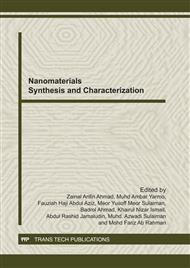p.485
p.489
p.494
p.500
p.504
p.510
p.515
p.519
p.524
Influence of Calcinations Temperatures on Structural and Photoluminescence Properties of ZnO Nanoparticles via Precipitation Method
Abstract:
Zinc oxide (ZnO) nanoparticles with spherical morphologies were successfully produced via precipitation of Zn and I2 with DEA was employed as a chelating agent. The products were further heat treated at four different calcinations temperature commences from 250 °C to 1150 °C. Studies on ZnO structural, morphologies and optical characteristic with respect to calcinations temperatures were conducted using XRD, TEM and PL spectroscopy respectively. The XRD spectra reveal hexagonal wurtzite signature along with preferred orientation growth in (101) plane. Particles size of ~ 60 nm and strong blue-violet emission peak of 417 nm (3.0 eV) has been observed for ZnO calcined at 850 ᵒC. Results reveal a close relationship between the calcinations temperature and ZnO microstructure whereas, its luminescence behaviour showing a strong depending on ZnO microstructure.
Info:
Periodical:
Pages:
510-514
Citation:
Online since:
October 2011
Authors:
Price:
Сopyright:
© 2012 Trans Tech Publications Ltd. All Rights Reserved
Share:
Citation:


